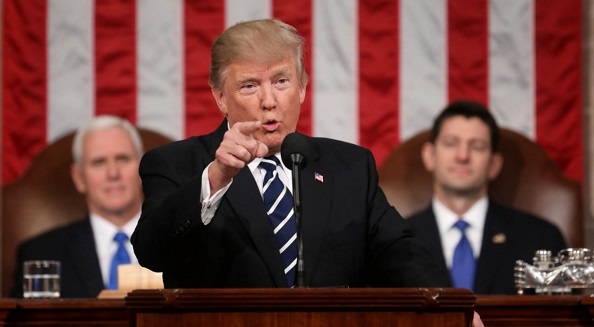What happened to the State of the Union address? Originally, it helped the president and Congress deliberate.

On Tuesday night, President Trump delivers his State of the Union address, as have scores of presidents before him. But the performance likely won’t do what it was originally designed for: framing a productive debate between two branches of government about the nation’s direction.
The State of the Union is in a state of decay, and has been since well before the age of Trump.
The Constitution states that the president “shall from time to time give to Congress Information on the State of the Union, and recommend to their Consideration such Measures as he shall judge necessary and expedient.” This directive is the ground from which our modern practice, bedecked with mass media pomp and circumstance, has grown. Televised viewership of the address has averaged around 40 million over the past decade. Theoretically, this gives the president a chance to lay out his vision for the country, to the country.
But is that what the address really does in practice?
Consider recent research by William Howell, Ethan Porter and Thomas Woods, which suggests that major presidential speeches such as the State of the Union can improve public perceptions of the president, especially among those who start with negative views of the speaker, without affecting viewers’ policy positions. The “power of public performance” has an effect independent of the message.
Further, while the president’s nominal audience is Congress, the real target is the American public beyond Congress, whom he can cajole while berating his partisan foes in the chamber before him.
As a result, the speech has become an unapologetically partisan performance, one part legislative manifesto, one part victory lap. Complete with its own hashtag, “SOTU” is a distillation of U.S. political culture, with the president’s expanded public role and the rise of “executive-centered partisanship” on full display.
It hasn’t always been this way.
Technology changed the State of the Union into a public performance
Developing technologies have changed the State of the Union, beginning with its broadcast on radio in 1923 and later on television in 1947. Today, as Trump frequently demonstrates, the president can promote his image and message more directly than ever through social media. These technologies shifted the president’s focus from the legislature in front of him to the voting public beyond them.
Heightened publicity stoked partisanship, a development emphasized in 1966 with the advent of the opposition “response.” Often delivered in the form of a rebuttal, the out-party’s response allows a partisan critique of the president’s assessment of what is “necessary and expedient” for the Union.
Although the response could foster productive argument, in practice neither speaker nor respondent actually engages the other. The opposition speaker writes the response before the president’s speech has been delivered. The opposition party does not so much respond to the president as imagine what rejoinder the waiting audience wants to hear. While the president’s address is directed to the public over Congress’ heads, the opposition response is directed to the public over the president’s head.
Continue Reading: What happened to the State of the Union address? Originally, it helped the president and Congress deliberate.
Comments
Post a Comment